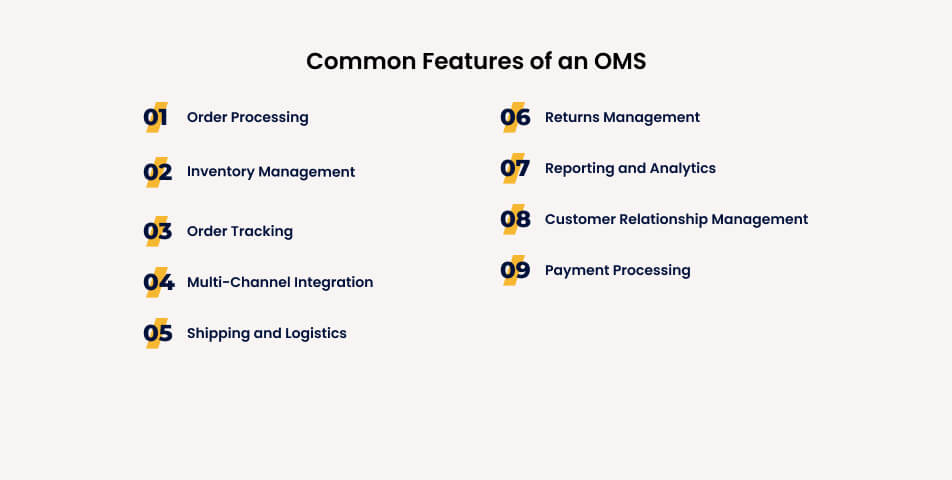Key Takeaway :
Order Management Systems (OMS) are crucial for streamlining the fulfillment process, centralizing order information, and enhancing the customer experience.
Choosing the best OMS for your business involves assessing your needs, defining key features, setting a budget, evaluating scalability, considering integration capabilities, researching vendor reputation, prioritizing customer support, and reviewing security and compliance.
The right OMS can elevate your operations and set the stage for business growth, making it an indispensable tool for businesses of all sizes.
What is an Order Management System (OMS)?
Order management Systems are the heartbeat of e-commerce, and the right order management system is your key to success.
It is a powerful software that streamlines the sales and fulfillment process, connecting all the dots from point of sale to delivery. With the right software, you will experience these features:
- Seamless order execution: Every order is handled efficiently within the order management process.
- Optimized order routing: Choose the best shipping options for timely fulfillment.
- Enhanced visibility: Keep track of order history and order volumes.
- Financial integration: Connect with ERP and financial systems for a holistic view.
As your business grows, order management requires advanced technology to meet increasing demands. It becomes essential, enabling you to manage operations with precision.
Whether you’re choosing or upgrading your current system, consider the features that align with your e-commerce goals. The right platform supports your business operations, drives growth, and delivers an exceptional customer experience. Unlock the full potential of your e-commerce venture with the best order management software!

How Does an OMS Work?
Once upon a time in the bustling world of commerce, there existed a magical tool that brought order to the chaos of the fulfillment process. This tool, known as the Order Management System, was the guardian of business growth, ensuring that every order was executed with precision and grace.
As the story goes, is concerned with connecting the dots between the sales and fulfillment process. It’s a type of software that acts as a conductor, orchestrating the symphony of commerce.
- Keep track of every note: Keep track of things like order details, inventory levels, and customer information. The system can help ensure that every order is harmoniously fulfilled.
- Compose new melodies: It enables businesses to explore new system features and advanced order options. With the best software, you’ll be able to customize the system to your unique business needs.
- Sing in harmony with others: Can also provide vendors with the following information, such as order status and shipping details. This collaboration ensures that everyone is singing from the same sheet of music.
- Perform on the grand stage: It typically integrates with an ERP systems, allowing businesses to manage their operations on a larger scale. With an OMS, you’re ready for the big leagues.
By choosing an order management system that aligns with your business goals, you can ensure that your fulfillment process is a masterpiece. Whether a small business or a global enterprise, and the right platform must be your trusted companion on the journey to success. With an OMS in place, businesses can achieve their dreams and reach new heights. It is not just a tool; it’s a beacon of hope, guiding businesses to a brighter future.
Also Read: 7 Best Ecommerce Help Desk for 2024
In the end, order management software helps create a world where every order is a symphony, and every business is a virtuoso.
Why is an OMS Important for Your Business?

- Streamlines the Fulfillment Process: It is important for your business because it streamlines the entire order fulfillment process, ensuring that orders are processed efficiently and accurately.
- Centralizes Order Information: It provides a centralized system for managing all order-related information, making it easier for your team to access and update order details.
- Enhances Customer Experience: Improving the order fulfillment process, also enhances the customer experience, leading to higher customer satisfaction and loyalty.
- Reduces Errors: With a system in place to manage orders, businesses can significantly reduce the likelihood of errors, such as shipping the wrong product or quantity.
- Provides Real-Time Updates: It must then update order statuses in real-time, allowing your team and customers to stay informed about the progress of each order.
- Facilitates Inventory Management: It can also help manage inventory levels, ensuring that products are available when needed and preventing stockouts or overstocking.
- Supports Business Growth: Automating and optimizing the sales and fulfillment process enables businesses to scale their operations and support growth.
- Integrates with Other Systems: It can also integrate with other business systems, such as accounting and shipping platforms, creating a seamless workflow and improving overall operational efficiency.
What are The Common Features of an OMS?

- Order Processing: The systems facilitate the order fulfillment process by allowing businesses to efficiently manage and process customer orders. This includes capturing order details, verifying payment information, and preparing orders for shipment.
- Inventory Management: It provides real-time visibility into inventory levels, helping businesses track available stock, prevent stockouts, and optimize inventory replenishment.
- Order Tracking: Offers order tracking features that enable customers and businesses to monitor the status of orders as they move through the fulfillment process.
- Multi-Channel Integration: It can integrate with multiple sales channels, such as online stores, physical retail locations, and marketplaces, allowing businesses to manage orders from all channels in one place.
- Shipping and Logistics: It automates shipping and logistics processes, including generating shipping labels, selecting carriers, and calculating shipping costs.
- Returns Management: It often includes features for managing returns and exchanges, making it easier for businesses to handle customer returns and process refunds or replacements.
- Reporting and Analytics: It provides reporting and analytics tools that give businesses insights into sales performance, order trends, and inventory levels, enabling data-driven decision-making.
- Customer Relationship Management: It can also integrate with customer relationship management (CRM) systems to manage customer information, order history, and communication preferences.
- Payment Processing: It can handle payment processing, including capturing payment details, processing transactions, and managing refunds, ensuring secure and efficient payment processing.
What are the different types of OMS?

There are several different types of OMS, each designed to meet specific business needs:
- Retail Designed for brick-and-mortar retail stores, this type of OMS helps manage in-store orders, inventory, and customer information.
- E-commerce Tailored for online businesses, this OMS manages orders placed through e-commerce websites and integrates with online shopping carts and payment gateways.
- Multichannel Ideal for businesses selling through multiple channels (e.g., online, in-store, marketplaces), this OMS centralizes order management across all sales channels.
- Wholesale Designed for B2B businesses, this OMS manages bulk orders, invoicing, and fulfillment for wholesale customers.
- Enterprise Suitable for large enterprises with complex operations, this OMS offers advanced features, such as integration with ERP systems, supply chain management, and customizable workflows.
- Cloud-Based Hosted on the cloud, this OMS provides remote access, scalability, and automatic updates, making it a flexible option for businesses of all sizes.
- On-Premises Installed on a company’s own servers, this OMS provides greater control over data security and system customization but may require more maintenance.
How Does an OMS Software Work?
An Order Management System software automates and streamlines the entire order management process, from order placement to fulfillment and delivery. Here’s an overview of how software typically works:
- Order Placement: The process begins when a customer places an order through a sales channel, such as an e-commerce website, a physical retail store, or a third-party marketplace. It captures the order details, including the products ordered, quantities, customer information, and payment details.
- Order Validation: It verifies the order information, including payment authorization and inventory availability. If there are any issues, such as insufficient inventory or payment failure, the system may notify the customer or the relevant team members.
- Order Routing: Once the order is validated, determine the optimal fulfillment method and route the order to the appropriate fulfillment center, warehouse, or store. This routing process may consider factors such as inventory levels, shipping costs, and delivery times.
- Order Fulfillment: The fulfillment center receives the order details from the software and begins the process of picking, packing, and preparing the order for shipment. It may also generate shipping labels and other necessary documentation.
- Shipping and Delivery: The order is handed over to a shipping carrier for delivery to the customer. It may provide tracking information to both the customer and the business, allowing them to monitor the progress of the shipment.
- Order Completion: Once the order is delivered to the customer, mark the order as complete. The system may also trigger post-purchase activities, such as sending a confirmation email or requesting customer feedback.
- Returns and Exchanges: If the customer needs to return or exchange an item, manage the returns process, including processing refunds or replacements and updating inventory levels.
- Reporting and Analytics: It provides reporting and analytics tools that allow businesses to analyze order data, monitor sales performance, and gain insights into customer behavior and inventory trends.
Overall, the software serves as a central hub for managing orders, inventory, and customer interactions, helping businesses optimize their operations and enhance the customer experience.
How Does an OMS Integrate With Your Existing Software Systems?
- An Order Management System integrates with existing software systems using Application Programming Interfaces (APIs) or pre-built connectors.
- Integration creates a seamless flow of data between the Software and other systems.
- Examples of integration:
- With e-commerce platform: Captures online orders.
- With Customer Relationship Management (CRM) system: Manages customer information.
- With Enterprise Resource Planning (ERP) system: Synchronizes inventory and financial data.
- Benefits of integration:
- Enables real-time data exchange.
- Automates workflows.
- Provides a unified view of business operations.
- Streamlines processes and reduces manual tasks.
- Improves data accuracy.
- Enhances overall operational efficiency.
How Does an OMS Track Order Information Across Multiple Sales Channels?
An Order Management System is like a master conductor, orchestrating the harmonious flow of order information across multiple sales channels. Here’s how it works:
- Unifying the Ensemble: It serves as a centralized hub, bringing together order data from various sales channels—be it online stores, physical retail locations, or third-party marketplaces.
- Capturing the Melody: As customers place orders through different channels, captures each order’s details, including products, quantities, and customer information, creating a symphony of data.
- Synchronizing the Rhythm: It ensures real-time synchronization of order information across all channels, so every update resonates throughout the system—whether it’s a new order, a cancellation, or a return.
- Fine-Tuning the Performance: It provides businesses with a holistic view of their sales performance across channels, allowing them to fine-tune their strategies and optimize inventory allocation.
- Delighting the Audience: By seamlessly tracking order information, delivers a pleasant customer experience, regardless of the sales channel, ensuring that every customer feels like a VIP at the grand concert of commerce.
How Does an OMS Manage Inventory Levels?
An Order Management System skillfully manages inventory levels like a master chess player, making strategic moves to optimize stock and prevent shortages. Here’s how it works:
- Real-Time Visibility: It provides a real-time view of inventory levels across all locations, including warehouses, stores, and distribution centers.
- Order Fulfillment: As orders are placed, it allocates inventory to fulfill each order, updating stock levels accordingly to ensure accuracy.
- Replenishment Alerts: It monitors inventory levels and sends alerts when stock is running low, prompting timely replenishment to prevent stockouts.
- Demand Forecasting: It analyzes historical sales data and order trends to forecast demand, helping businesses plan inventory purchases and optimize stock levels.
- Inventory Allocation: Strategically allocates inventory across sales channels and locations, balancing supply and demand to maximize sales opportunities.
- Returns Management: It handles returns and exchanges, updating inventory levels to reflect returned items and making them available for resale.
- Reporting and Insights: It generates inventory reports and provides insights into stock performance, helping businesses make data-driven decisions for inventory management.
What Are The Key Metrics an OMS Should Measure?
An Order Management System should measure the following key metrics to provide valuable insights into business performance:
- Order Volume: The total number of orders received over a specific period.
- Order Fulfillment Time: The average time is taken to fulfill an order from the moment it is placed to the time it is shipped.
- Order Accuracy Rate: The percentage of orders that are fulfilled accurately without errors (e.g., wrong product, incorrect quantity).
- Order Cancellation Rate: The percentage of orders that are canceled by customers or by the business due to issues such as stockouts.
- Return Rate: The percentage of orders that result in returns or exchanges.
- Inventory Turnover: The number of times inventory is sold and replaced over a specific period, indicating how efficiently inventory is managed.
- Stockout Rate: The percentage of time that products are out of stock, leading to lost sales opportunities.
- Backorder Rate: The percentage of orders that cannot be immediately fulfilled due to insufficient inventory and are placed on backorder.
- Average Order Value (AOV): The average revenue generated per order, is calculated by dividing total revenue by the number of orders.
- Gross Margin: The difference between revenue and the cost of goods sold (COGS), indicating the profitability of sales.
- Fulfillment Costs: The total costs associated with fulfilling orders, including picking, packing, shipping, and handling.
- Customer Satisfaction: A measure of customer satisfaction with the order fulfillment process, typically assessed through customer feedback and reviews.
Choosing the Best Order Management System
What are the top OMS platforms available in the market?
- Magento Commerce Order Management (MOCM): A cloud-based Software that integrates with the Magento e-commerce platform and provides multichannel order management capabilities.
- Shopify Plus: The enterprise version of Shopify includes advanced order management features for high-volume merchants and large businesses.
- Brightpearl: A retail operations platform that offers order management, inventory control, and automation for omnichannel retailers.
- NetSuite Order Management: Part of the Oracle NetSuite ERP suite, platform offers order processing, inventory management, and fulfillment capabilities.
- IBM Sterling Order Management: An enterprise-level software that provides visibility into inventory, order orchestration, and fulfillment across multiple channels.
- SalesWarp: A platform that offers order processing, inventory management, and shipping solutions for retailers and e-commerce businesses.
- Zoho Inventory: An inventory and order management software that integrates with multiple sales channels and provides real-time inventory tracking.
- Orderhive: A cloud-based order management platform that offers features such as order processing, inventory management, and shipping automation.
- Skubana: An e-commerce operations platform that provides order management, inventory control, and analytics for multichannel sellers.
- TradeGecko (now QuickBooks Commerce): An inventory and order management platform that integrates with e-commerce platforms and marketplaces.
How to choose the best OMS for your business needs?
- Assess Your Business Needs: Start by identifying your business’s unique order management requirements. Consider factors such as sales channels, order volume, fulfillment methods, and inventory management needs.
- Define Key Features: Make a list of the key features you need in the right platform. Common features include order processing, inventory management, multichannel integration, order tracking, shipping automation, and reporting.
- Set a Budget: Determine how much you’re willing to invest in the right platform. Consider both the initial implementation costs and ongoing expenses, such as subscription fees and maintenance costs.
- Evaluate Scalability: Choose a platform that can scale with your business as it grows. The system should be able to handle increasing order volumes and support additional sales channels or locations.
- Consider Integration Capabilities: Ensure that it can integrate seamlessly with your existing software systems, such as e-commerce platforms, accounting software, and Customer Relationship Management (CRM) systems.
- Research Vendor Reputation: Research the reputation and track record of potential vendors. Look for customer reviews, case studies, and testimonials to gauge the reliability and performance of the system.
- Request a Demo: Request a product demonstration from vendors to see the platform in action. Use the demo to evaluate the user interface, ease of use, and system functionality.
- Prioritize Customer Support: Choose a vendor that offers reliable customer support and training. Access to prompt and knowledgeable support can be crucial for resolving issues and maximizing the value of the software.
- Evaluate Customization Options: Determine whether it can be customized to meet your specific business processes and workflows. Flexibility is important for adapting the system to your needs.
- Review Security and Compliance: Ensure that the platform meets industry standards for data security and compliance. This is especially important if you handle sensitive customer information and payment data.
Conclusion: Choose an OMS that suits your business
In conclusion, Order Management Systems are the maestro that orchestrates the harmonious flow of orders from placement to fulfillment. With its ability to streamline processes, provide real-time visibility, and enhance customer experiences, it is an indispensable tool for businesses of all sizes. A guide to order management systems is going to help you throughout in a way how using the right platform helps elevate your business. Whether you’re an e-commerce merchant, a brick-and-mortar retailer, or a multichannel seller, the right platform can elevate your operations to new heights by decreasing manual order management and setting the stage for business growth. As you embark on your quest to find the perfect software, let this guide be your compass, leading you to a solution that resonates with your unique needs and aspirations.





